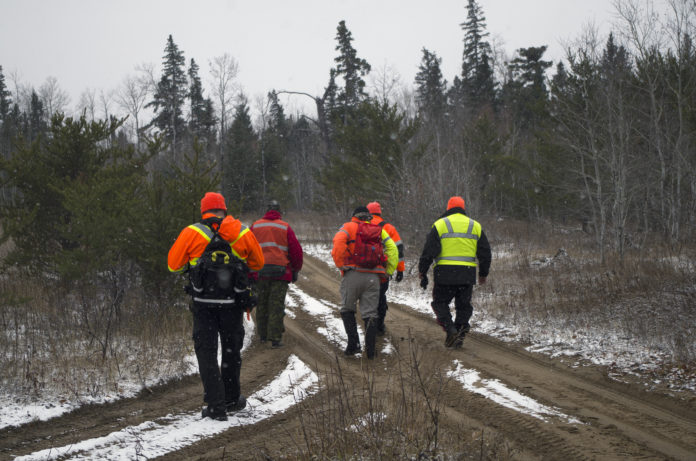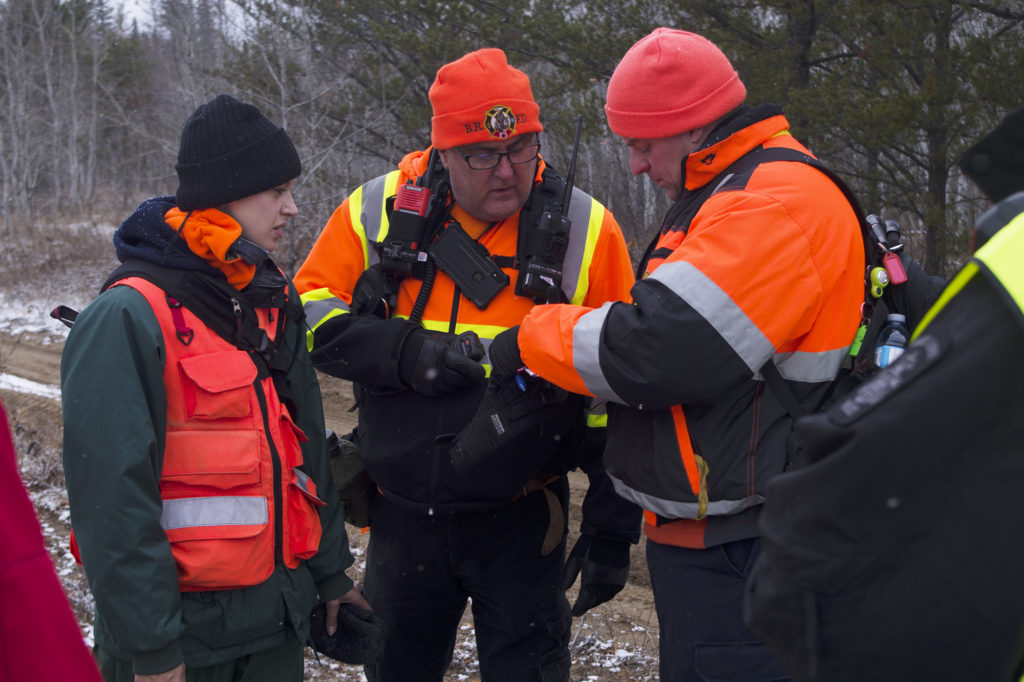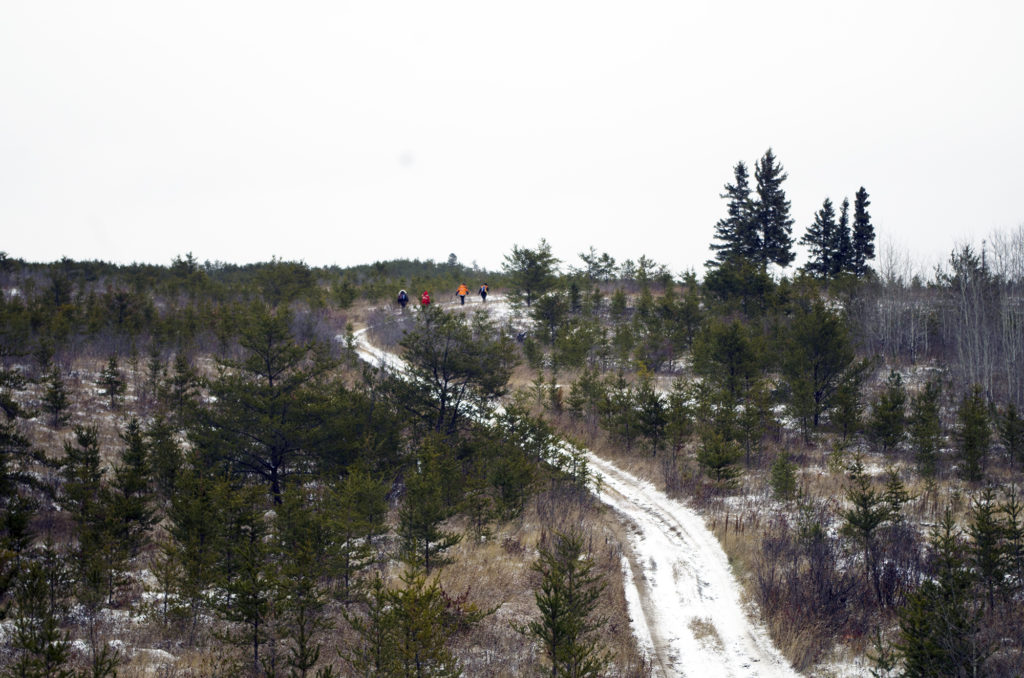
On the ground with the Search and Rescue Saskatchewan Association of Volunteers
At 7:30 a.m. on what will be the last day before winter, a 17-year-old teenage boy is reported missing.
Not long afterwards, so is his girlfriend. By 10:30 a.m., four teenagers in total have reportedly disappeared after a night of partying, along with two ATVs from a residence in the nearby hamlet of Crutwell.
It looks like a standard search and rescue operation, but there are a few twists to it. The first involves the 17-year-old teenager. He’s not real.
To be more precise, he’s an actual person, but he’s not 17, and he didn’t spend the night at a bush party before vanishing into the late-autumn air. He’s an actor, and so are his two companions and his girlfriend.
The ATVs are real, however. A volunteer has driven them into the backwoods outside Crutwell, which sits almost halfway between Prince Albert and Shellbrook, just south of Highway 3. They’ll sit there, along with the four actors, until search and rescue crews can find them. So begins another Multi-Jurisdictional Search Exercise, a weekend-long training and testing activity designed to prepare search and rescue crews for the real thing.
“This is real world stuff,” says my guide, Search and Rescue Saskatchewan Association of Volunteers (SARSAV) media liaison Dustin Brears. “It’s just on a bigger scale than normal.”
He’s not kidding. This weekend’s exercise will involve between 50 and 60 trained SARSAV volunteers, along with representatives from more than half-a-dozen different police, emergency service and rescue organizations. That list includes local groups like Prince Albert North Search and Rescue, Buckland Search and Rescue, RCMP and the Prince Albert Grand Council.
In addition to putting their training to the test, today’s exercise will also help evaluate the new data management and resource tracking project made possible by the SAR NIF, otherwise known as the Search and Rescue New Initiative Fund.
It’s a unique experience, especially for a volunteer like Brears, who hails from the SARSAV’s Yorkton chapter. He’s used to making searches in urban areas with buildings and alleyways, or in fields broken only by sloughs, tree lines and the odd clump of brush. Searching through forests like this one is a rare opportunity, and he’s happy to be a part of it.
“When we walk in a bush (in Southern Saskatchewan) we come out the other side because it’s a bluff,” he says during a short break. “In this bush, you don’t come out the other side.”
So what do searchers look for? Well, in this instance, it’s footprints and tire tracks, the last one being both the easiest and hardest to find. How? Well, it’s not difficult to spot ATV tracks in this area. The trick is discovering which ones are the most recent. Search teams are trained to pick out details that help distinguish between older and more recent tracks, along with signs on the trail that might show if someone broke off and started into the bush on foot.
There are also time and weather elements to consider. What started as a damp and chilly fall day has quickly turned into frigid winter one. By early afternoon, fat flakes of snow are tumbling to the ground while the wind whips through the evergreens. Soon the winding dirt track, which was once quickly walked and easily scanned, will be covered in a thin layer of late October snow. The skies, meanwhile, will start to get darker at around 5:45 p.m. By 7:30 p.m., it will be almost completely black.
“Depending on how long (they’re out there), the weather, all kinds of things, (command) may decide by 5 p.m., ‘you know what, there’s a very real chance of us finding these people alive,’” Brears explains. “Then they’re going to put a night operational period on and put us out with flashlights and everything else. It’s also dependent on the safety of the searchers. If this was (an area with) extremely rocky cliffs and (was) dangerous to walk around at nighttime, it would be a different story.”
The likelihood of finding a missing person or persons dictates how long teams search, or what resources they use. Brears, who averages about one search a month with the Yorkton SARSAV, has been on some that lasted several days. As long as crews think the missing person is alive, they’ll keep pushing and pushing.
“The powerful part is if somebody goes missing, there’s people coming from all over the province,” he says. “They’re coming on their own time and dime to help people in need.”
No job left undone

It’s difficult to simulate the sense of urgency that accompanies a search, but team leaders and volunteers do the best they can. For this exercise, they’re hoping to find the missing teens and their ATVs by 3 p.m.
In a real search, the victims might be suffering from frostbite, dehydration or hypothermia, but today, there’s only one downside to missing the 3 p.m. target. The Saskatchewan Roughrider game starts at five, and a few people are hoping they won’t have to miss the opening kickoff.
Unfortunately, the team that’s closest to the target is at a juncture, literally. The track they’re following has merged with another, so they’ve got a map out trying to plan their next move.
Team leader Joel Perreault, one of many Prince Albert North Search and Rescue volunteers out today, consults with his squad for a few minutes before they decide to keep heading west. That will take them even further away from Crutwell.
“Based on a description of the people missing (and) potential vehicles or ATVs that they might have used, we’ll look for clothing articles, discarded gloves or boots or hats, and then for the actual ATV or UTV itself,” he says. “If you find that ATV, typically the victims are nearby.”
Perreault joined Prince Albert North SAR in 2010. He liked the outdoors and enjoyed being part of a team. He also wanted to give back to the community, so connecting with a search and rescue organization made perfect sense. By 2014 he was the group’s president, a role he still holds today.
“We need volunteers because it’s strength in numbers,” he explains. “The more people we can have responding to an activation to bring loved ones home, the better…. More eyes, more boots on the ground, and everything happens much quicker for the family.”
The choice to head west was a smart one. About 10 minutes later, Perreault and his team turn a corner and see a yellow ATV sitting in a small loop off the side of the trail. There are two girls huddled next to it, trying to find refuge from the cold October wind.
The rescue crew starts handing out water and blankets, just as they would in a real operation (in reality, the two girls are both clad in warm winter gear, and have had a chance to warm up in a Saskatchewan Public Safety Agency spotter vehicle that stopped by). They also send a report back to command. Perreault’s team has found one ATV. Yes, just one.
The other is long gone. Their ATV ran out of fuel, one girl tells Perreault, and they stayed behind while her boyfriend and another companion left to get gas. They haven’t been heard from since. Even though it’s after 3 p.m., the search will continue.
Tragic beginnings

On July 14, 1994, eight-year-old Ashley Krestianson and her twin sister Lindsay were exploring the area around a vacation ranch near Tisdale. Lindsay followed a trail back to the ranch, but Ashley decided to take a shortcut on the way home and disappeared.
Hundreds of volunteers came out to help RCMP officers search for her, along with 80 soldiers from CFB Shilo in Manitoba. It was no use. Terrible weather, including several days of hard rain, hindered their efforts, and her body wasn’t found until late September.
The tragedy helped local RCMP realize the need for trained volunteers to help in future searches. It also helped local communities realize that having committed volunteers wasn’t enough. They needed to be well organized and disciplined. Not long afterwards, the Search and Rescue Saskatchewan Association of Volunteers was born. Today the organization has 19 chapters spread across Saskatchewan, with professional volunteers from Estevan to La Loche.
“When I say professional volunteers, I mean they’re trained to a professional standard,” Brears explains. “They can identify this stuff that other people would normally just walk right over.”
We run into a few of those volunteers not long after Perreault’s team finds the first ATV. The four members of Team Victor Golf have discovered another set of tracks, potentially those belonging to the second pair of teenagers. They were originally following them west, only to hear the report from Perreault’s team over the radio.
It’s a lucky break for Victor Golf. Our vehicle has inadvertently scuffed those tracks, making them difficult to follow further west.
Brears offers an apology, but he’s stopped by a searcher wearing army fatigues, and a vest with “Canadian Rangers” written on the back in bold, black letters.
“It happens in real life,” says the man, who seems pleased rather than discouraged by the new challenge.
Perreault’s team catches up with us not long afterwards. There’s a short discussion, a weighing of options, and a new plan. Team Victor Golf turns back east, where the brush gets thinner and most of the evergreens haven’t grown taller than five or six feet. The trail is almost solid white by now, but the air clears and the snow stops falling.
At around 4:24 p.m. we hear two voices calling out from over the crest of a small hill. We reach the top and see another yellow ATV perched right on the edge of a steep ravine. A shallow creek runs through the bottom, and sitting next to it, bundled up and ready for rescue, are our 17-year-old teen and his buddy. We’ve come so far south we can easily see the North Saskatchewan River through the gaps in the trees.
There’s still a lot to do before the rescue part of this search and rescue operation is over. The 17-year-old says his buddy has a broken back after tumbling over the edge, and can’t climb the ravine slopes by himself.
It’s going to take the Saskatchewan Public Safety Agency’s six-member low-angle rescue team to pull them up, and they have to be called up from the command centre, located further east towards Prince Albert. It will be another 10 to 15 minutes before they arrive, and soon after that, members from the rest of the search teams will start trickling in.
But in a few moments, they’ll all hear over the radio the same thing I’m hearing from the volunteer right next to me.
“This is Victor Golf to command,” she says. “We have found the missing quad and the missing boys.”
To volunteer with or donate to the Search and Rescue Saskatchewan Association of Volunteers, visit sarsav.ca.
This is an updated story. The original version of the story said there are 16 chapters across the province instead of 19. The Herald regrets the error.

